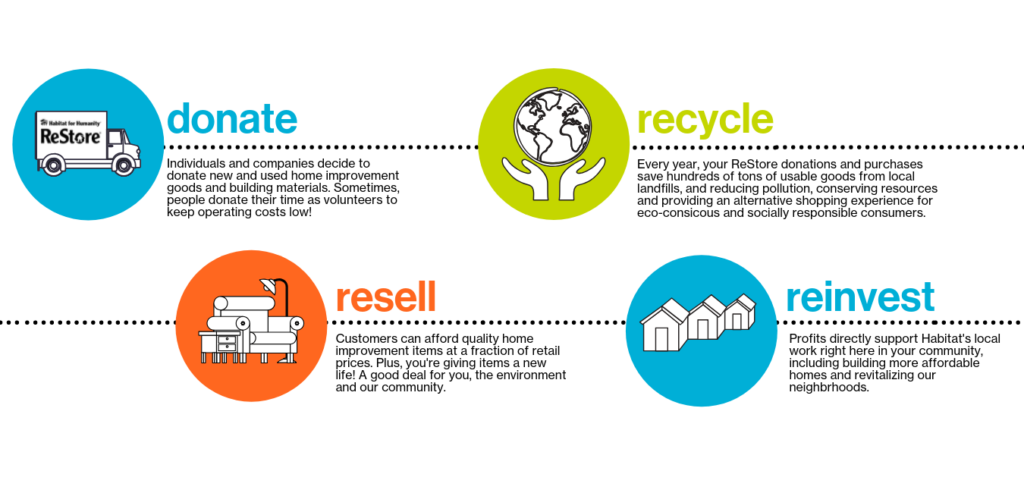Have you ever looked around a Habitat ReStore and wondered how all those items got there? Or have you considered donating, and wondered how that process works? Here at Habitat for Humanity Halton-Mississauga-Dufferin, we get a lot of questions about our donation process and just exactly how things work in our social enterprise outlets. We thought we’d break it down in a blog post so that you can see exactly how it works.
Your item is picked up from your home, or dropped off to a ReStore
The first step in your donation process is to get your donation to a ReStore warehouse. There are two ways that this can happen. The first is that you arrange to have your item picked up through Habitat’s free home pickup service. You can schedule your free pickup from your garage, driveway or moving room, or you can have your item picked up from a room inside your home. Start by filling out our convenient online donation form.
A member of our scheduling team will review the items you’d like to donate, as well as the photos you’ve attached, and help you move forward with the next steps of your donation process. On the day of your donation pickup, our team of professional volunteers and staff will arrive at your scheduled time and remove your item. You will receive a charitable tax receipt for donations — be sure to indicate if you’d like this receipt when you schedule your donation.
The second way that items arrive at our ReStore is that they are donated by members of our community. We welcome donations of items such as new and used home furniture, kitchens and kitchen cabinetry, new-condition sinks, toilets and vanities, hardware, tools, new and like-new windows, seasonal tools and supplies, appliances in working condition, home decor, lighting and electrical accessories and more. When these items are dropped off during our operating hours, we’re able to take them into the warehouse and begin the next stage of the donation process.
Visit our ReStore website to find a full list of our accepted donation items, as well as items that we have to say “no thank you” to. In addition to donations from individuals in the community, we welcome donations from corporations. These might include overstock, returned items or imperfect items that cannot be sold by the company. These donations give the ReStore more products to offer, and ultimately contribute to Habitat’s overall efforts to build safe, decent and affordable homes.
Items are priced
Once donations arrive at the ReStore warehouse, they are priced by our team of volunteers. Items are sold for 30 to 70 per cent of their original retail value. If donors have requested a charitable tax receipt, then this is when that information is processed based on the item’s fair market value.
Items are placed on the floor or head to the ReVive Centre
After being priced, an item is ready to go on the ReStore floor. Depending on the ReStore location the overall setup of the store is different, but most are organized categorically so you can find items of the same kind in the same place. Before going out on the floor, some items with DIY potential first go to our ReVive Centre, where volunteers and corporate teams upcycle them. They might add a fresh coat of paint, or construct something entirely new out of pallets of wood or another donated item. After getting an upcycling treatment at ReVive, those items will then be sold in a ReStore with a special price tag indicating that they were specially hand-crafted in ReVive.
Items are purchased by a ReStore customer
Once being placed on the floor, an item is purchased by a ReStore customer. Maybe it’s the perfect addition to their new living room, or part of a DIY project they’re working on. In any case, once the item is purchased, those funds make a big difference for Habitat for Humanity. Twenty per cent of our overall ReStore funds go towards covering our administrative costs like buying staples and keeping the lights on. The remaining 80 percent go towards paying for programming and build costs, such as land purchase and development costs.
Allowing some of the proceeds of sales from items in the ReStore to go towards our administrative costs means that we can guarantee that 100 per cent of monetary donations go right into our home building projects. When items are donated to the ReStore by an individual or company, this gives us more products to sell. We are very grateful to both
In addition to helping us have product to put on the floor, donating to the ReStore prevents otherwise usable items from ending up in a disposal depot. In the last six years, Habitat Halton-Mississauga-Dufferin ReStores have diverted over 5.3 million pounds’ from disposal areas. In this way, our ReStores are also a green initiative that helps us to positively impact the environment as well as our local community.

Donate to a Habitat for Humanity ReStore today
If this donation process sounds like something you’d like to be involved with, then donate to your local Habitat for Humanity ReStore today. Habitat for Humanity Halton-Mississauga represents Burlington, Mississauga, Oakville, Milton, Halton Hills and Georgetown. Habitat for Humanity GTA serves Brampton, Caledon, Toronto, Scarborough and the region of York. Habitat Durham represents Ajax Oshawa and Uxbridge, and Habitat Hamilton serves the region of Hamilton. To find your closest Habitat ReStore, check out Habitat for Humanity Canada’s ReStore locator.
You can schedule a free pickup online for any items you would like to donate, or drop off your items. We’re excited to get involved with you and make your donation as smooth as possible so that we can ultimately raise more funds and help more families find safe and decent shelter. To learn more about the work that Habitat is doing in your community, visit our website.

